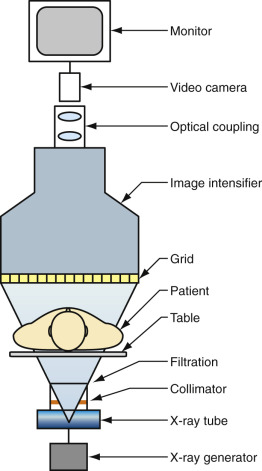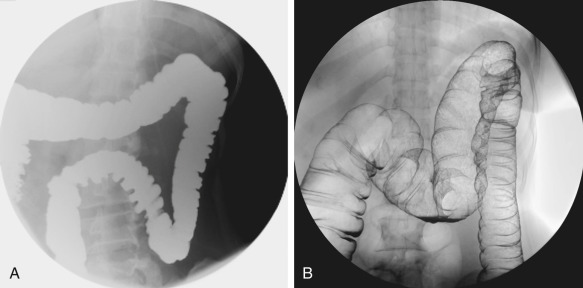Physical Address
304 North Cardinal St.
Dorchester Center, MA 02124
Fluoroscopy is a type of imaging technique in which real-time movements of body organs and radiopaque contrast material are visualized. During a fluoroscopic examination, the operator or radiologist controls the functions of radiography equipment and x-ray tubes for real-time imaging of the patient. In abdominal imaging, fluoroscopy has a role in the diagnosis of various clinical conditions with gastrointestinal studies, postoperative studies, genitourinary studies, and more.
Early fluoroscopes had an x-ray tube and fluorescent screen made of barium platinocyanide. Gradually, the screens were replaced by cadmium tungstate and then zinc-cadmium sulfide, which produced a yellow-green emission.
Fluoroscopy has evolved from the early days of images on a fluoroscopic screen of poor quality, a dark radiography room, and eye adaptation with red goggles to improved images with image intensifiers, video-recorders, and a variety of C-arm machines. Currently, it is available in many different configurations for use in various clinical applications. With technologic advancements in hardware and image processing, fluoroscopy has gained substantially both qualitatively and quantitatively. The introduction of flat-panel detectors, high-quality image intensifiers with video-recording capabilities, state-of-the-art C-arm design, and digital units has revolutionized the field of fluoroscopic imaging. The superior spatial and contrast resolution combined with faster image reconstruction and reduced radiation along with a variety of safe and effective contrast media has empowered fluoroscopy with advanced capabilities in the diagnostics and interventional realm. A variety of fluoroscopic units are now commercially available, and the components of basic fluoroscopic equipment are shown in Figure 2-1 . The main uses of fluoroscopy are listed in Box 2-1 .

Gastrointestinal imaging
Genitourinary imaging
Angiography
Other:
Intraoperative
Foreign-body removal
Musculoskeletal
It is important to have the patient empty his or her stomach to increase the sensitivity of the fluoroscopy examination, because food and food residue can mimic disease. Informed consent is required, and any medical history such as heart disease, asthma, allergy, thyrotoxicosis, and hypersensitivity to drugs should be elicited. Also important to consider: What medications (e.g., insulin) is the patient using? Is the patient pregnant or breast-feeding? Has there been a recent diagnosis of small bowel obstruction or perforation and, if so, what were the surgical details?
Patients scheduled for a double-contrast barium enema must adhere to a clear liquid diet for 24 hours before the procedure. Laxatives may be prescribed to ensure thorough bowel cleansing, and on the morning of the examination a bisacodyl suppository is given per rectum.
However, in the acute/emergency or postoperative setting, patient preparation is usually optional. Moreover, in this setting, iodinated contrast media are preferred over barium sulfate because the latter might interfere with a surgical procedure and any extraluminal collection of barium may create confusion with a diagnosis on subsequent examinations. A medical history of severe hypersensitivity to iodinated contrast media or certain medications should be obtained if the procedure requires its use.
Fluoroscopic examinations are of two types: single-contrast studies and double-contrast studies ( Box 2-2 ). Single-contrast studies are performed either with barium or with iodinated contrast media. For double-contrast media, air or carbon dioxide is used ( Figure 2-2 ).
Precise control of barium column
Easier identification of filling defects
In suspected perforation, single contrast with water-soluble medium preferred
Can be used to evaluate mechanical problems (e.g., obstruction, fistula)
Optimal for patients unable to swallow gas-forming tablets
Thick barium coats lumen, and effervescent tablets ingested to distend lumen with air
Produced see-through effect with better assessment of mucosal details
Better distention and separation of the bowel loops
Better detection of small mucosal lesions, polyps, ulcers

Stomal examinations, enema through ileostomy or colostomy for patency, recurrence of disease, and leak
Feeding tube studies
Oral cholecystogram and T-tube cholangiogram
Hydrostatic reduction of pediatric abdominal emergencies such as intussusceptions and sigmoid volvulus
Cystography for evaluation of urinary bladder and vesicoureteric reflux
Voiding cystourethrography for visualization of urethra
Retrograde urethrography for anterior urethra
Hysterosalpingogram for uterus and fallopian tubes
Become a Clinical Tree membership for Full access and enjoy Unlimited articles
If you are a member. Log in here